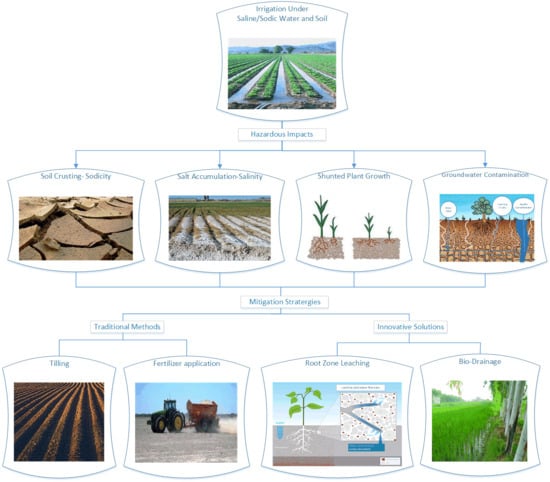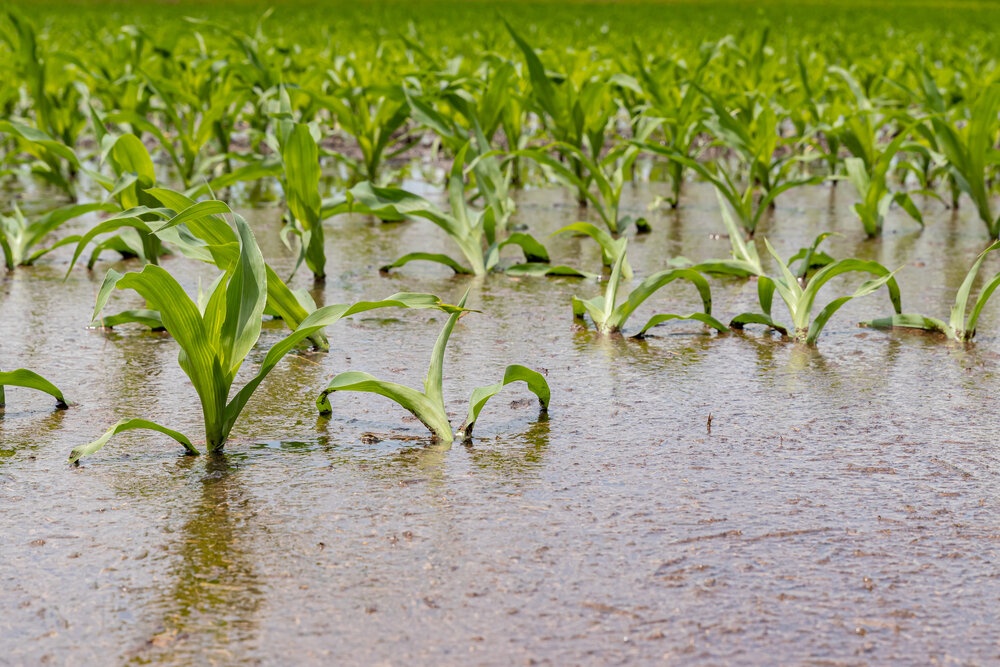Are you aware that giving your crops too much water might actually harm them? You might be surprised to learn that while water is essential for plant growth, over-irrigation can lead to a host of problems.
These issues can affect your crops’ health, yield, and even your profits. Imagine your plants struggling, not because of drought, but because of too much water. It’s like when you overwater a houseplant and its leaves turn yellow and limp.
This isn’t just a backyard issue; it’s a significant concern for farmers and gardeners everywhere. Understanding the impact of over-irrigation is crucial for ensuring your crops thrive. Dive into this article to uncover the hidden dangers of over-irrigation and discover practical solutions to keep your plants healthy and productive. Your crops’ future health might just depend on it.

Signs Of Over-irrigation
Excess water can cause root rot and nutrient leaching in crops. Yellow leaves and slow growth are common signs. Soil compaction and reduced oxygen can further impact plant health.
Over-irrigation can stealthily affect your crops, compromising their health and productivity. Recognizing the signs early can save you time and resources, and preserve the vitality of your farm. But how do you know when you’ve crossed the line with watering? Let’s dive into the telltale signs your crops might be experiencing too much of a good thing.Excess Water Runoff
When your fields start showing excessive water runoff, it’s a clear signal that your crops have had enough—or perhaps too much. This runoff can lead to soil erosion and nutrient loss, which are detrimental to plant growth. You might notice water pooling in areas that should be dry, indicating that the ground is saturated beyond its capacity.Yellowing Leaves
Have you noticed your plant leaves turning yellow? This is a common indication of over-irrigation. When plants receive too much water, their roots can’t breathe, leading to oxygen deprivation. The result is yellowing leaves, often mistaken for nutrient deficiency. Checking your irrigation schedule might reveal the real culprit behind this color change.Root Rot
Root rot is another consequence of over-irrigation, where roots drown and decay due to excessive moisture. You might see stunted growth or wilting, even though you’ve been generous with water. If you dig up a plant and find mushy or dark roots, it’s a sign that your watering practices need adjustment.Fungal Growth
Over-irrigated fields often become breeding grounds for fungi. Mushrooms sprouting unexpectedly might be an indicator of high moisture levels. Fungal growth can quickly spread diseases among your crops, undermining their health. It’s essential to manage irrigation to prevent these unwanted guests from taking over.Soil Compaction
Too much water can lead to soil compaction, making it hard for roots to penetrate and access nutrients. You might notice the soil surface becoming hard and crusty, challenging the growth of your crops. This compaction reduces air pockets in the soil, impairing root health. Have you ever felt that despite your best efforts, your crops aren’t thriving? Assessing your irrigation habits could unveil the answer. By identifying these signs, you can adjust your water management strategies and ensure your crops flourish. Remember, nurturing your plants is about balance—not just the quantity of water, but its timing and distribution. How will you ensure your irrigation practices support, rather than hinder, your crop health?
Soil Saturation Problems
Soil saturation problems are a critical issue that arises from over-irrigation. When you water your crops excessively, the soil becomes waterlogged, preventing plants from getting the oxygen they need to thrive. This can lead to a host of problems, from poor plant growth to nutrient leaching, directly impacting crop health and yield.
Soil Compaction And Reduced Aeration
When soil is saturated, it becomes heavy and dense. This compaction reduces air spaces within the soil, making it difficult for roots to breathe. Have you ever noticed your plants wilting despite being well-watered? It might be due to a lack of oxygen in the soil. Consider testing soil moisture and adjusting your watering schedule to ensure the roots are getting the air they need.
Nutrient Leaching
Excessive water can wash away vital nutrients from the soil. Imagine pouring a cup of water into a bowl of sugar—the sugar dissolves and disappears. Similarly, nutrients like nitrogen and potassium can be washed deep into the soil, out of reach for your plants. This nutrient loss can lead to deficiencies, affecting plant growth and productivity. Would you consider using soil amendments to retain nutrients better?
Increased Risk Of Plant Diseases
Over-irrigation creates a damp environment, which is a breeding ground for fungi and bacteria. Ever noticed mold or mildew on your plants? This could be due to excessive watering. These diseases can quickly spread, damaging crops and reducing yield. Think about implementing a more balanced irrigation system to mitigate these risks.
Impact On Crop Yield
Ultimately, soil saturation can severely impact your crop yield. Waterlogged soil affects root development, nutrient uptake, and plant health. Have you ever wondered why your harvest was smaller than expected? It might be worth evaluating your irrigation practices. By optimizing water use, you can improve soil health and boost crop production.
Are you experiencing soil saturation problems in your fields? It’s essential to assess and adapt your irrigation methods to protect your crops and maximize your yield. How can you adjust your watering practices to prevent these issues?
Nutrient Leaching Effects
Over-irrigation can have harmful effects on crops. One major issue is nutrient leaching. This occurs when excess water washes nutrients away from the soil. Plants need these nutrients to grow strong and healthy. Without them, crops can become weak and less productive.
What Is Nutrient Leaching?
Nutrient leaching happens when water moves through the soil. It carries nutrients like nitrogen and potassium with it. These nutrients dissolve in water easily. When they wash away, plants can’t absorb them. This leads to nutrient deficiency in crops.
Causes Of Nutrient Leaching
Excessive watering is a primary cause. Over-irrigation creates too much water in the soil. This excess water pushes nutrients deeper into the ground. They end up beyond the reach of plant roots.
Effects On Crop Yield
Nutrient leaching reduces the availability of essential elements. Without these nutrients, plants grow slower and weaker. This leads to lower crop yields. Farmers may see smaller harvests and reduced profits.
Soil Health Impact
Leaching also affects soil health. It strips the soil of its natural fertility. Over time, this can lead to barren lands. Rebuilding soil fertility can take many years.
Signs Of Nutrient Leaching In Crops
Yellowing leaves are a common sign. This indicates a nitrogen deficiency. Stunted growth is another symptom. Crops may also produce smaller fruits or grains.
Prevention Of Nutrient Leaching
Monitor irrigation closely. Use water-efficient methods like drip irrigation. Test soil regularly to check nutrient levels. Apply fertilizers carefully to avoid excess. These practices can help minimize leaching.

Strategies For Sustainable Water Use
Over-irrigation harms crop health by drowning roots, reducing oxygen levels, and encouraging diseases. It leads to nutrient loss and weak plants. Sustainable strategies focus on balanced watering to maintain healthy growth and protect yields.
Strategies for sustainable water use are crucial for maintaining crop health and ensuring that farming practices do not harm the environment. Over-irrigation can lead to water wastage, soil erosion, and reduced crop yields. By adopting smart water management techniques, farmers can optimize water usage, enhance productivity, and contribute to a healthier ecosystem. The path to sustainable water use in agriculture is paved with practical strategies. Let’s dive into some actionable insights that can transform your irrigation practices. ###Precision Irrigation Techniques
Precision irrigation allows you to apply the right amount of water at the right time. Using sensors and data analytics, you can monitor soil moisture levels and weather conditions. This technology helps in reducing water wastage and promoting better crop growth. Have you ever considered how much water you could save by knowing exactly when your crops need it? ###Rainwater Harvesting
Rainwater harvesting is a sustainable way to supplement irrigation needs. Collecting and storing rainwater during wet seasons can provide an additional water source during dry spells. This strategy not only conserves groundwater but also prepares you for unexpected droughts. How often do you let rainwater go to waste when it could be nourishing your crops? ###Crop Rotation And Diversity
Crop rotation is not just about improving soil fertility; it can also impact water usage. Different crops have varying water requirements, and rotating them can help optimize water usage across seasons. Embracing crop diversity ensures that your irrigation practices are adaptable and efficient. Have you noticed how some crops thrive with less water while others demand more? ###Drip Irrigation Systems
Drip irrigation is a highly efficient method of watering crops directly at the root level. This system reduces evaporation and runoff, ensuring water is used where it’s needed most. Implementing drip irrigation can significantly lower your water consumption while enhancing crop health. Have you explored the benefits of this targeted approach in your fields? ###Regular Maintenance And Monitoring
Regularly checking and maintaining your irrigation systems can prevent leaks and inefficiencies. Monitoring tools can provide real-time data on water usage and help you adjust your strategies as needed. Keeping an eye on your systems ensures that every drop counts. Could you be missing out on savings by overlooking simple maintenance? ###Community Collaboration And Education
Collaborating with local farmers and sharing best practices can lead to collective benefits. Community education on sustainable water use fosters a culture of conservation and innovation. Learning from each other amplifies efforts and results. Have you tapped into the power of community knowledge to refine your irrigation practices? Adopting these strategies not only supports your farming goals but also contributes to a more sustainable future. By being mindful of water use, you protect your crops and the environment. How will you make your irrigation practices more sustainable today?Conclusion
Over-irrigation harms crop health and reduces yield. Waterlogged soil suffocates roots, leading to disease. Proper irrigation practices help maintain soil balance. Farmers should monitor water levels regularly. This ensures plants get just the right amount. Using technology can optimize water usage.
Efficient irrigation saves water and boosts plant health. Sustainable farming methods are vital for long-term success. By managing water wisely, we protect crops and the environment. Adopting smart irrigation techniques benefits everyone. Healthy crops mean better food security. Let’s prioritize sustainable practices for future generations.



